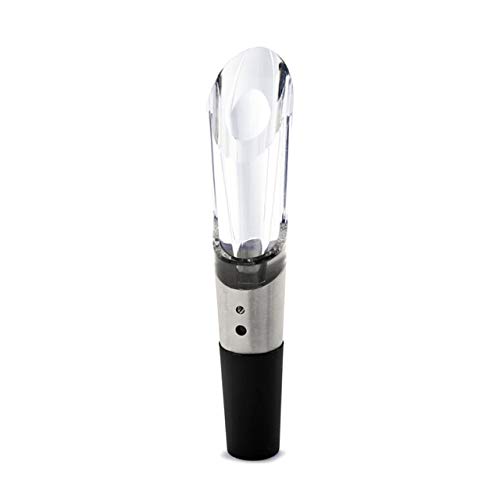Wine aerators are very popular among wine enthusiasts. To be honest, we’ve rare rarely used wine aerators at KnowWines because we prefer to use a decanter or to age wine in a wine cabinet. So, we set out to investigate why wine aerators are so popular.
Wine aerators exist so that we can drink now (well, once we get the screw cap off or release the cork from the bottle!). Studies show that 90% of American wine consumers drink the wine they purchase within two weeks of purchase, and of that 50% is consumed within 2-3 days. So, it makes sense that wine aerators are popular. We decided to open a couple of bottles and try out the very best wine aerators (all in the name of research, of course!).
Before we continue with our recommendations, though, a little about the KnowWines blog. We are an Amazon.com affiliate and we do receive a small commission if you purchase items through our affiliate links at no cost to you. The commissions we receive help us pay for web hosting fees, products to test, and other costs associated with running this site. Thanks for using our affiliate links and supporting our independent blog!
What Is a Wine Aerator?
Honestly, any product that one can pass wine through is technically a wine aerator. But can be also be aerated through a specially designed wine accessory called a wine aerator. These devices are typically made from various plastics and may or may not include a metal mesh to collect wine sediments or cork debris. Wine aerators typically have a cylindrical path for wine to flow through and an inlet allowing precise exposure of oxygen to the flowing wine. They may or may not include a stand. Alternatively, wine can be aerated using a blender, large wine glass, or classically a decanter.
What Does a Wine Aerator Do?
When aerating younger wines, an aerator simply serves as a vessel for carefully exposing young wine to oxygen before it is consumed. Exposing wine to oxygen allows the young wine to breathe and open up. Some frequently heard comments expressed by wine drinkers after tasting aerated wine are:
“This wine has a better bouquet.”
“The flavors are more enhanced.”
“This has a smoother finish.”
We don’t personally recommend using a handheld wine aerator for older wines with sediment. The sediment can clog the filter or the device, resulting in wine spills or extra time at the kitchen sink. With older bottles of wine, we prefer using a decanter and enjoying the entire bottle with friends!
Do I Need a Wine Aerator?
No. You can find a lot of advice online telling you that you can “make your wine taste twice as expensive by using a wine aerator.” However, the same effect can be had by using traditional wine aeration methods like a decanter, a blender (for ultra-fast aeration), or simply letting the wine sit in a glass for a while (15 minutes or more).
However, we understand that not all wine drinking is “fine wine drinking.” There’s definitely a time and a place for beverage wines in our busy lifestyles! We don’t all have time to get out decanters and plan hours ahead for a five-star drinking experience. That’s why these wine aerators are a good tool for minimizing wait time between opening a bottle of wine and enjoying it. And if you tend to purchase and consume quite a few bottles of younger wines each month, this would be a good investment for you!
And here’s a KnowWines secret: we do keep one wine aerator on hand. When we have a white wine that we think could be improved by aeration, rather than decanting the whole bottle, we pass some of the white wine (75 - 100 mL) through a simple handheld wine aerator made by Vinturi. If we are pleased with the preliminary results, we then decant the bottle.
Where Can I Buy A Wine Aerator?
Wine Aerators can be found in most of the following retail locations:
Independent bottle shops
Large wine stores like Total Wine & More
Big-box retailers like Target, Walmart, and Bed Bath & Beyond (though it may take a little hunting around or asking a sales associate!)
Online
What Is the Best Wine Aerator?
We own only one wine aerator, the Vinturi. We didn’t actually give this purchase much thought. The Vinturi simply looked easy to use and easy to clean. Also, it had a minimal footprint and was on sale at our favorite local wine bottle shop. So, we gave the Vinturi a try, and we’re happy we did!
Like we said, we don’t use wine aerators often, but for the times we do, we’ve been quite happy with the Vinturi. And after further research, the Vinturi looks to have a strong fan base, with lots of positive comments.
Positive reviews address enhanced aromas and flavors of everyday wines, ease of use, and simple clean-up. The product also comes with a stand, which gathers the drips after use in case you want to come back and use it in an hour or so before cleaning it.
Negative reviews highlight a common flaw with acrylic composition - if the item is dropped, it may have a propensity to develop hairline cracks that are either cosmetic in nature or that eventually impact the utility of the item. This is true of many acrylic items and can also occur with the age of the item, rather than as the result of dropping it.
For folks with manual dexterity challenges (or those who simply want to aerate a glass of wine without holding onto the aerator), Vinturi has designed this tower for less cumbersome aeration.
How Do I Use a Wine Aerator?
We’ve made this simple video to show you how to use the wine aerator. (Don’t worry, it’s a pretty straightforward process!)
Simply pour the desired volume of wine (75 to 150 mL) through the aerator positioned above your glass. After using the wine aerator, place it back into the stand. If you only intend to use it once, place it directly into the dishwasher or sink.
How Do I Clean and Store a Wine Aerator?
Most wine aerators are dishwasher safe. However, they are small and may get damaged in a dishwasher if the dishwasher is not loaded correctly. You can also clean the aerator with dish soap and water. If you can’t get it clean, try placing the aerator in a glass dish, cover the aerator with warm water, and add a table of denture or retainer cleaner.
One can also attack any blockage in one of the tubes by using compressed air - the same compressed air one uses to remove dust from electronics and computers. We like this rechargeable and cordless compressed air tool as it eliminates the waste associated with cans of compressed air.
When the aerator is not in use, keep it on a stand to keeping it from rolling around in a drawer. Keep away from other heavy items to prevent the acrylic portion from breaking.
Finally…Why Do Wine Aerators Look Like Adult Toys?
We wonder if we are alone in this assessment? But humor us for a second. Here is a popular personal massager ...
And here are a few popular wine aerators on the market in addition to our favorite Vinturi…
This one, too …
And also this one …
But, we digress!
Wine Aerator Summary
Aerating wine simply exposes wine to oxygen in a controlled manner. Today’s busy lifestyles don’t always allow us to plan in advance and use traditional methodologies like decanters.
Much of the wine purchased and consumed in the United States is drank within the first two weeks. Wine aerators can increase the enjoyment of wine, especially when a single person or couple just wants to enjoy one glass in an evening.
KnowWines recommends the Vinturi Wine Aerator. We don’t use it often, bit it does come in handy when we want to quickly learn how well a wine we just opened might respond to aeration in a classic decanter.
A Little Footnote
Like the hourglass in the Vinturi photo? I purchased it in Napa Valley at Pennyweight in St Helena, California. If you can’t find a similar item there, they are also available here:
Happy aerating! And cheers!









